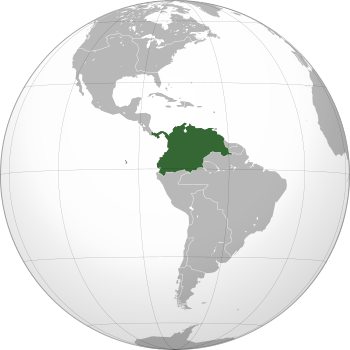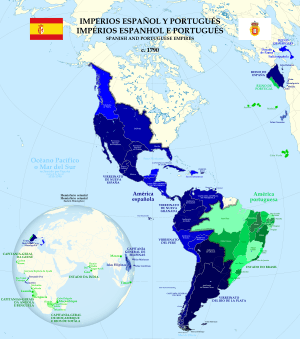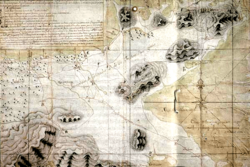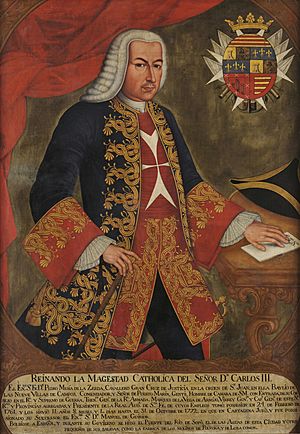Viceroyalty of New Granada facts for kids
Quick facts for kids
Viceroyalty of New Granada
Virreinato de la Nueva Granada
Virreinato del Nuevo Reyno de Granada |
|||||||||||||||||||||||||
|---|---|---|---|---|---|---|---|---|---|---|---|---|---|---|---|---|---|---|---|---|---|---|---|---|---|
| 1717–1723 1739–1810 1816–1822 |
|||||||||||||||||||||||||
|
Motto: Utraque Unum
"Out of two (worlds) one" |
|||||||||||||||||||||||||

Viceroyalty of New Granada
|
|||||||||||||||||||||||||
| Status | Viceroyalty of the Spanish Empire | ||||||||||||||||||||||||
| Capital | Santa Fé de Bogotá | ||||||||||||||||||||||||
| Common languages | Spanish (official, administrative) Indigenous languages (Arawakan languages, Barbacoan languages, Chibchan languages, Guajibo languages, Páez, Ticuna) |
||||||||||||||||||||||||
| Religion | Roman Catholicism | ||||||||||||||||||||||||
| Government | Monarchy | ||||||||||||||||||||||||
| Kings | |||||||||||||||||||||||||
|
• 1717–1724 (first)
|
Philip V | ||||||||||||||||||||||||
|
• 1813–1822 (last)
|
Ferdinand VII | ||||||||||||||||||||||||
| Viceroy | |||||||||||||||||||||||||
|
• 1718–1719 (first)
|
Antonio Ignacio de la Pedrosa y Guerrero | ||||||||||||||||||||||||
|
• 1819–1822 (last)
|
Juan de la Cruz Mourgeón | ||||||||||||||||||||||||
| Historical era | Spanish colonization of the Americas | ||||||||||||||||||||||||
|
• Established
|
27 May 1717–1723 1739–1810 1816 |
||||||||||||||||||||||||
|
• Suppressed
|
5 November 1723 | ||||||||||||||||||||||||
|
• Reestablished
|
20 August 1739 | ||||||||||||||||||||||||
| 8 September 1777 | |||||||||||||||||||||||||
|
• Independence declared
|
20 July 1810 | ||||||||||||||||||||||||
| 3 September 1816 | |||||||||||||||||||||||||
| 24 May 1822 | |||||||||||||||||||||||||
| Currency | Spanish real | ||||||||||||||||||||||||
|
|||||||||||||||||||||||||
The Viceroyalty of New Granada was a large area in northern South America. It was part of the Spanish Empire. This region included what we know today as Colombia, Ecuador, Panama, and Venezuela.
The Viceroyalty was first created on May 27, 1717, by King Felipe V of Spain. This was done to better control the Spanish lands. It was stopped for a short time in 1723 because of money problems. But it was brought back in 1739. The Viceroyalty lasted until 1810, when people started fighting for independence.
Later, in 1777, the areas of Venezuela became a separate region called the Captaincy General of Venezuela. Besides the main countries, the Viceroyalty also included parts of Guyana, Trinidad and Tobago, southwestern Suriname, and northern Peru.
Contents
Life in the Spanish Colony
For about 200 years, the area was known as the New Kingdom of Granada. Its governor reported to the Viceroy in Lima, Peru. But it took a very long time for messages to travel between these two places. This slow communication led to the creation of the independent Viceroyalty of New Granada in 1717.
The capital city was Santa Fé de Bogotá (now Bogotá, Colombia). This made Bogotá one of the most important Spanish centers in the New World. Other important cities were Lima and Mexico City. The Spanish government tried to make things more efficient. But it was hard for Spain to control everything from so far away.
The land in northern South America was very rugged and diverse. This made travel and communication inside the Viceroyalty difficult. To help with this, some areas like Venezuela got their own special governments. This also meant that different parts of the Viceroyalty developed their own traditions. These differences later played a role when these areas became independent countries.
The Wayuu Rebellion
The Spanish never fully took control of the Wayuu people. The Wayuu lived in a constant state of war with the Spanish. There were many rebellions over the years. In 1718, a Spanish governor called the Wayuu "barbarians" and "without God." The Wayuu were special because they learned how to use guns and horses.
In 1769, the Spanish captured 22 Wayuu people. They wanted them to work on building forts in Cartagena. The Wayuu reacted strongly. On May 2, 1769, near Riohacha, they burned their village. They also captured a priest. The Spanish sent a group to fight the Wayuu. This group was led by José Antonio de Sierra, a mestizo (a person of mixed European and Indigenous ancestry).
The Wayuu recognized Sierra. They forced his group to hide in a house, which they then set on fire. Sierra and eight of his men died. News of this success spread quickly. More Wayuu men joined the revolt. At its peak, about 20,000 Wayuu fighters were involved. Many had guns from English and Dutch traders.
The rebels took over and burned many Spanish settlements. Over 100 Spanish people were killed, and many were taken prisoner. The Wayuu also took many cattle. The Spanish took shelter in Riohacha and asked for help from other cities. Spanish soldiers arrived, and the rebellion slowly ended. But the Wayuu had won back much of their land.
The Comunero Revolt
There was another important uprising called the Comunero Revolt. This happened in 1781. It was a protest against new taxes and rules from the Spanish government. People from different social groups joined together. Even though the revolt was eventually put down, it showed the growing desire for change.
Becoming Independent
After the Spanish took back control for a short time, the fight for independence started again. Spain was weaker, which helped the independence movement. Leaders like Simón Bolívar and Francisco de Paula Santander led the fight. Bolívar returned to New Granada in 1819. He led an army over the Andes mountains.
His army won a big victory at the Battle of Boyacá on August 7, 1819. This led to independence being declared in 1821. By 1822, the Spanish forces were defeated in what is now Colombia. By 1823, they were defeated in Venezuela.
The territories of the Viceroyalty became fully independent from Spain between 1819 and 1822. They joined together to form a new country called Gran Colombia.
Later, Gran Colombia broke apart. This led to the creation of Ecuador, Venezuela, and the Republic of New Granada. The Republic of New Granada, with its capital in Bogotá, lasted from 1831 to 1856. The name "Colombia" came back later when the country was called the "United States of Colombia" after a civil war.
Population and Cities
In 1819, it was thought that about 4,345,000 people lived in New Granada.
Here are some of the main cities by population at that time:
- 1 – Santa Fe de Bogotá
- 2 – Caracas
- 3 – Cartagena de Indias
- 4 – Quito
- 5 – Panama
- 6 – Cuenca
- 7 – Popayán
- 8 – Tunja
- 9 – Santa Marta
- 10 – Guayaquil
See also
 In Spanish: Virreinato de Nueva Granada para niños
In Spanish: Virreinato de Nueva Granada para niños
- History of the Americas
- History of Colombia
- History of Ecuador
- History of Venezuela
- List of Viceroys of New Granada
- Spanish Empire
- Criollo people






